Overview
One sensor, two applications
HarvestLab 3000 and John Deere Constituent Sensing on a John Deere self-propelled forage harvester.
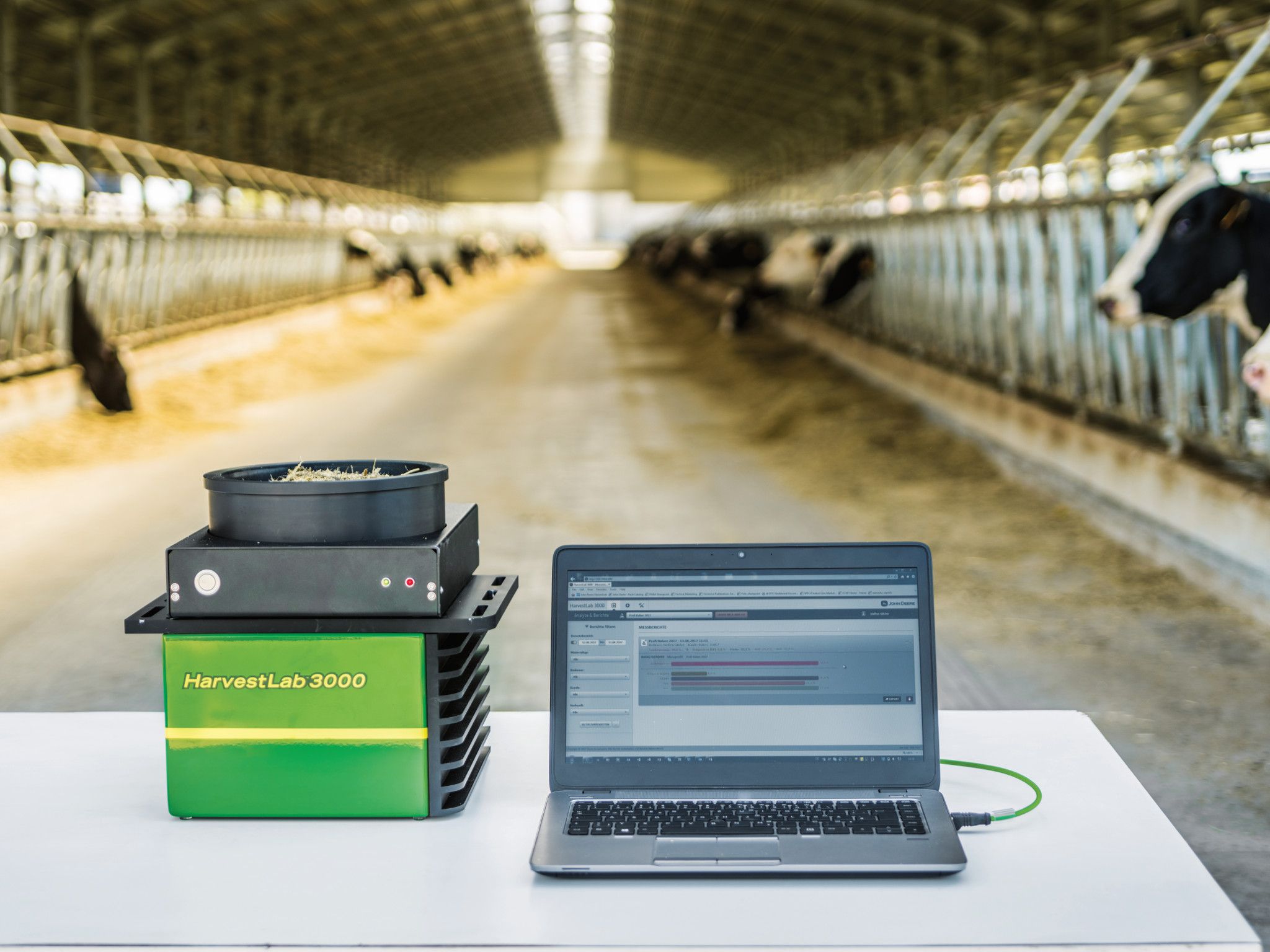
Plan ahead
For better fertilization planning in the next season, operators can use the HarvestLab 3000 sensor to determine and document the nutrient values taken off the field during harvest.
- On-the-go measuring of moisture, dry matter, protein, starch, fiber, neutral detergent fiber, acid detergent fiber, and sugar
- Automatically adjust inoculant dosage based on current dry matter level
- Automatically adjust length-of-cut, on the go
- The HarvestLab 3000 equipped with a turn table ensure a more frequent and more accurate evaluation of the ensiled material before rations are mixed.
- Utilize your HarvestLab 3000 all year long with the dual use capabilities of the Sensor for forage harvest and bunk management with the stationary turn table.
Features
The HarvestLab™ 3000 sensor can be used for two different applications:
- HarvestLab 3000 and John Deere Constituent Sensing on a John Deere self-propelled forage harvester
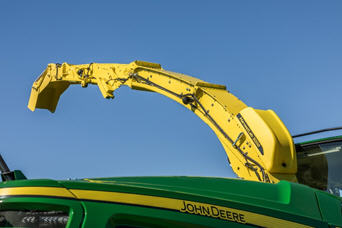
The HarvestLab 3000 sensor enables an accurate measurement and documentation of dry matter, starch, protein, neutral detergent fiber, and acid detergent fiber in different crop types. For better fertilization planning in the next season, operators can use the HarvestLab 3000 sensor to determine and document the nutrient values taken off the field during harvest. It also helps achieve higher quality forage by enabling automatic length-of-cut adjustments on the go to ensure an optimal bunker compaction and conservation. In addition, the smart use of additives ultimately leads to higher milk yields and more efficient use of feed.
- Measure yield while harvesting
- Accurately determine moisture, dry matter, protein, starch, fiber, neutral detergent fiber, acid detergent fiber, and sugar on-the-go
- Better determine the value of forage when purchasing for biogas operations
- Dose inoculants based on current dry-matter level
- Automatically adjust length of cut on the go
- Stationary application by adding a stationary kit to the HarvestLab 3000 and connecting it to a computer
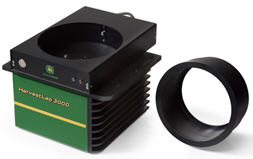 HarvestLab 3000 equipped with the HarvestLab 3000 stationary kit
HarvestLab 3000 equipped with the HarvestLab 3000 stationary kitThe HarvestLab 3000 sensor and stationary kit can provide time and cost savings with use in the barn, field office, or anywhere feed analysis is needed. For example, the components of a total mix ratio (TMR) can be measured every day to ensure the correct mix ration and achieve the maximum milk yield.
- Monitor silage quality all year round
- Support daily feed ration calculation
- Determine moisture, dry matter, protein, starch, fiber, neutral detergent fiber, acid detergent fiber, and sugar within 2 minutes
Measured data can also be downloaded from the HarvestLab 3000 sensor and saved to a computer for record-keeping purposes or to share with a nutritionist.
 HarvestLab™ 3000 mounted on spout of a John Deere 8000 Series Self-Propelled Forage Harvester
HarvestLab™ 3000 mounted on spout of a John Deere 8000 Series Self-Propelled Forage HarvesterDeveloped and patented with Carl-Zeiss, the HarvestLab™ 3000 sensor simultaneously measures the dry matter and various constituents of harvested crops. The HarvestLab 3000 uses the same near-infrared-reflectance (NIR) technology entrusted and used by most nutrition labs, but produces results instantly and with over 4000 readings per second. This provides producers with not simply one random sample value but statistically solid data on the go.
HarvestLab™ 3000 sensor provides on-the-go yield, moisture and constituents data when used in conjunction with the Harvest Monitor™ system. This instantaneous information can then be recorded and documented by using the Harvest Doc™ mapping system and a StarFire™ 6000 Receiver.
Each operation is unique, but in general, silage harvested in a matter of days is expected to feed herds the entire year or be sold throughout the year.
Considering harvest conditions are never perfect and feed quality never improves after harvest or during storage, effective management and the ability to react quickly and efficiently becomes paramount.
The HarvestLab 3000 sensor allows producers to make informed management decisions at harvest and during storage in order to maximize silage and feed quality from the day it is harvested to the day it is fed or sold.
Much value stems from obtaining instantaneous yield, moisture, and constituent data. Producers can do the following:
- Quickly identify if the crop has reached the optimal moisture to harvest
- Prevent downtime while waiting for the moisture measurements via drying ovens
- Automatically adjust the length-of-cut and inoculant levels to the optimal level
- Optimize the bunk density and fermentation for heightened silage and feed quality
- Segment the storage facilities based on the moisture or constituent content
- Compare hybrid/variety productivity
- Acquire dry volumes
- Enhance invoicing and documentation
For further information regarding the constituents, see John Deere Constituent Sensing in the Sales Manual.
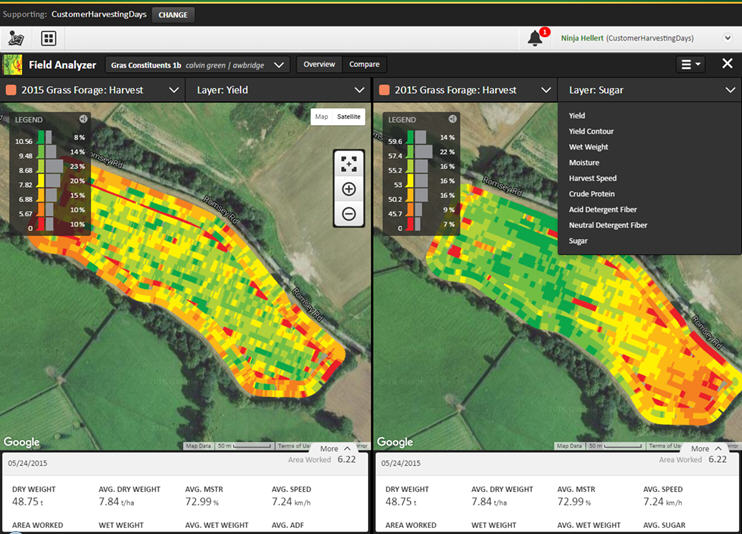
Data recorded with the HarvestLab™ 3000 sensor on the forage harvester can be sent wirelessly to the John Deere Operations Center. Data is available to view in Field Analyzer after a field has been completed and new work has started, or approximately one half hour after field work has been stopped. Producers can analyze data from completed fields or view where field work is in process, making it easier for them to make operational decisions. Data is available for analysis from any internet-connected device to make important production decisions and gives operations the ability to invoice work recently completed.
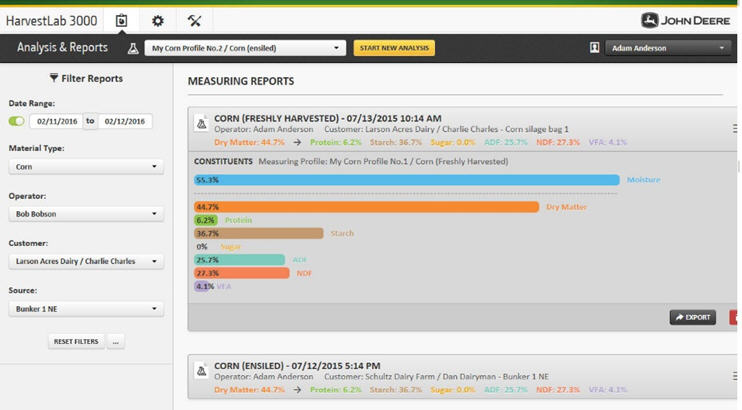 Improved web user interface in stationary application
Improved web user interface in stationary application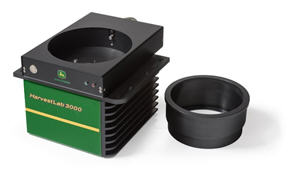 HarvestLab™ 3000 equipped with the HarvestLab 3000 stationary kit
HarvestLab™ 3000 equipped with the HarvestLab 3000 stationary kitEasily connect the HarvestLab 3000 sensor with the HarvestLab 3000 stationary kit. The sensor can be removed from a forage harvester or manure tanker in a matter of minutes. The stationary kit offers a practical and easy-to-use solution to measure forage quality away from the John Deere self-propelled forage harvester.
- Monitor silage quality all year round
- Better determine the value of forage when purchasing for biogas operations
- Support daily feed ration calculation
- Determine dry matter, protein, starch, fiber, neutral detergent fiber, acid detergent fiber, and sugar within 2 minutes
- Supply power with 12-V cigarette lighter adapter for mobile use
Operate the stationary application using the intuitive web-user interface, including improved measurements procedure with detailed step-by-step explanations. Store measurements or export them in the CSV format.
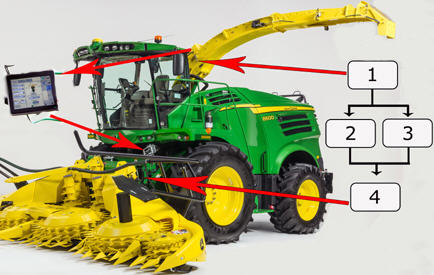 John Deere 8000 Series Self-Propelled Forage Harvest (SPFH) with HarvestLab™ 3000 and AutoLoc
John Deere 8000 Series Self-Propelled Forage Harvest (SPFH) with HarvestLab™ 3000 and AutoLoc- HarvestLab 3000
- Manual control (operator)
- AutoLoc — automatic length-of-cut control
- Infinitely variable length of cut (IVLOC™) — length-of-cut changes on-the-go
Save up to 5 percent fuel while increasing throughput leveraging AutoLoc.
AutoLoc, a feature exclusive to John Deere, brings added value to the HarvestLab moisture sensor and John Deere self-propelled forage harvester (SPFH). AutoLoc works in conjunction with the HarvestLab 3000 sensor and IVLOC to automatically adjust the length of cut based on crop-moisture levels to improve bunk density. Nutritionists, herdsmen, and SPFH operators will all benefit from this innovation.
John Deere is leading the industry in providing real-time information that matters most to forage production. Quality forage comes from properly packed silage, which is directly related to the moisture content and length of cut of the crop.
Length-of-cut changes are made automatically in the field based on moisture readings and predetermined settings determined by operator requirements. No in-field calibration is required to load the length-of-cut (LOC) requirements; the operator simply uses the GreenStar™ display to program the desired LOC settings at different moisture levels.
When moisture levels of crop in the field change, the hydrostatic IVLOC feedroll drive automatically responds to either an increase or decrease the feedroll speed, which in turn changes the LOC. If moisture levels of the crop are outside of the desired range, IVLOC adjusts and limits the LOC, based on the maximum and minimum LOC settings, as determined by the operator.
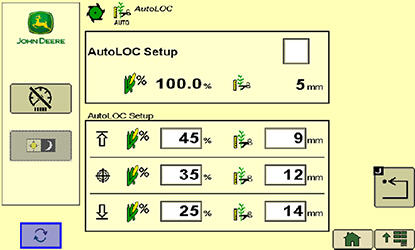 AutoLoc screen
AutoLoc screen

